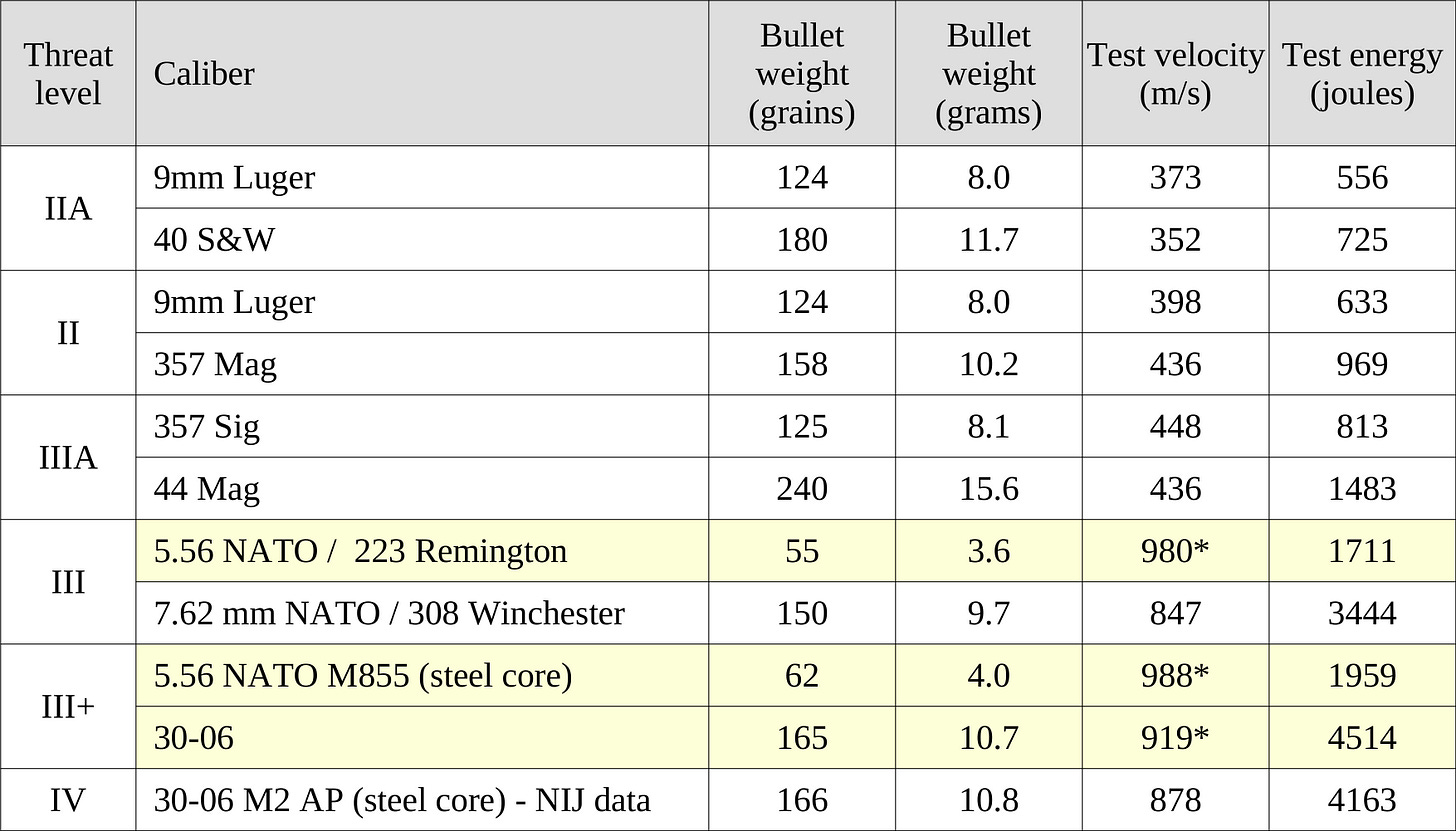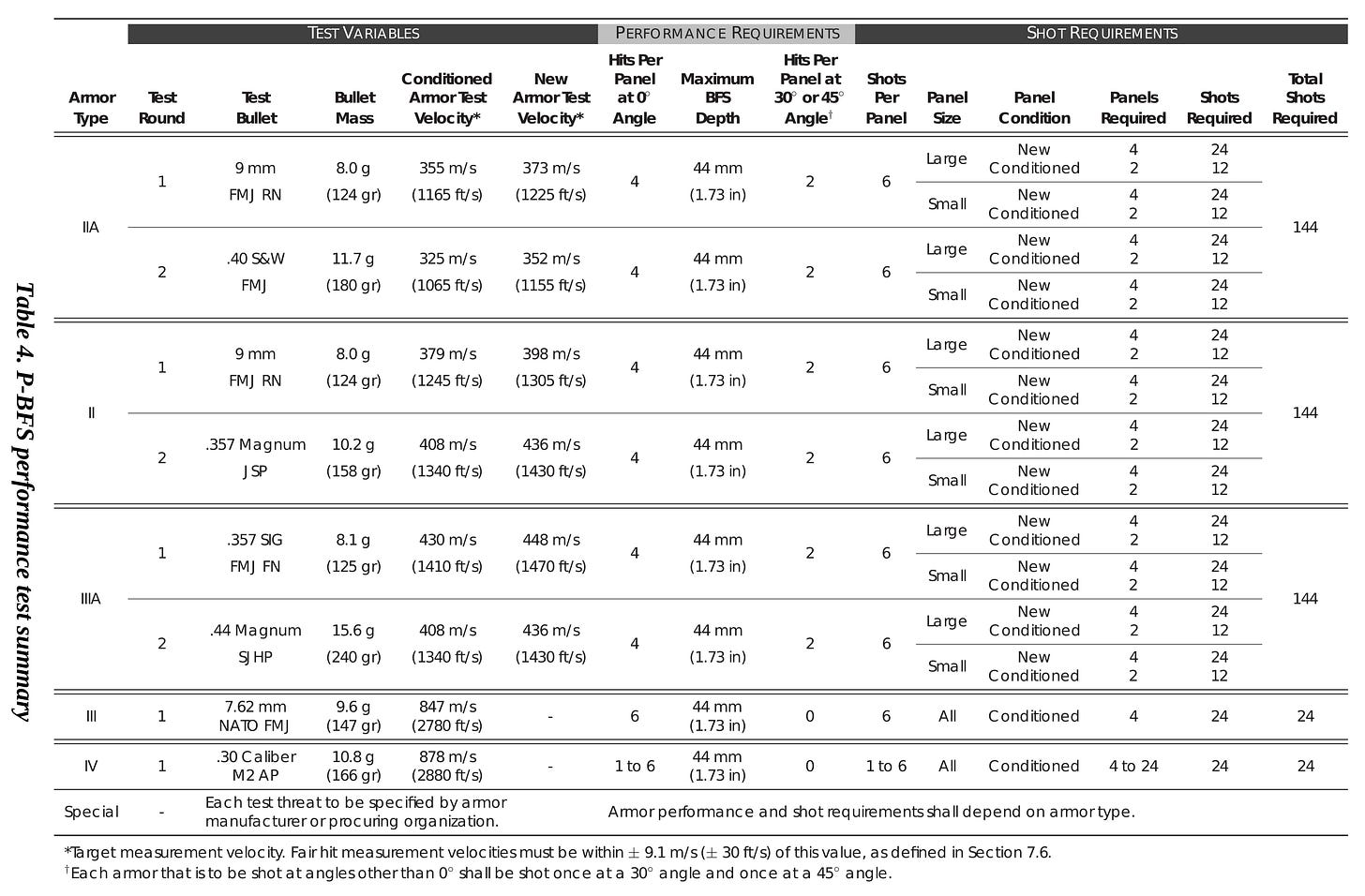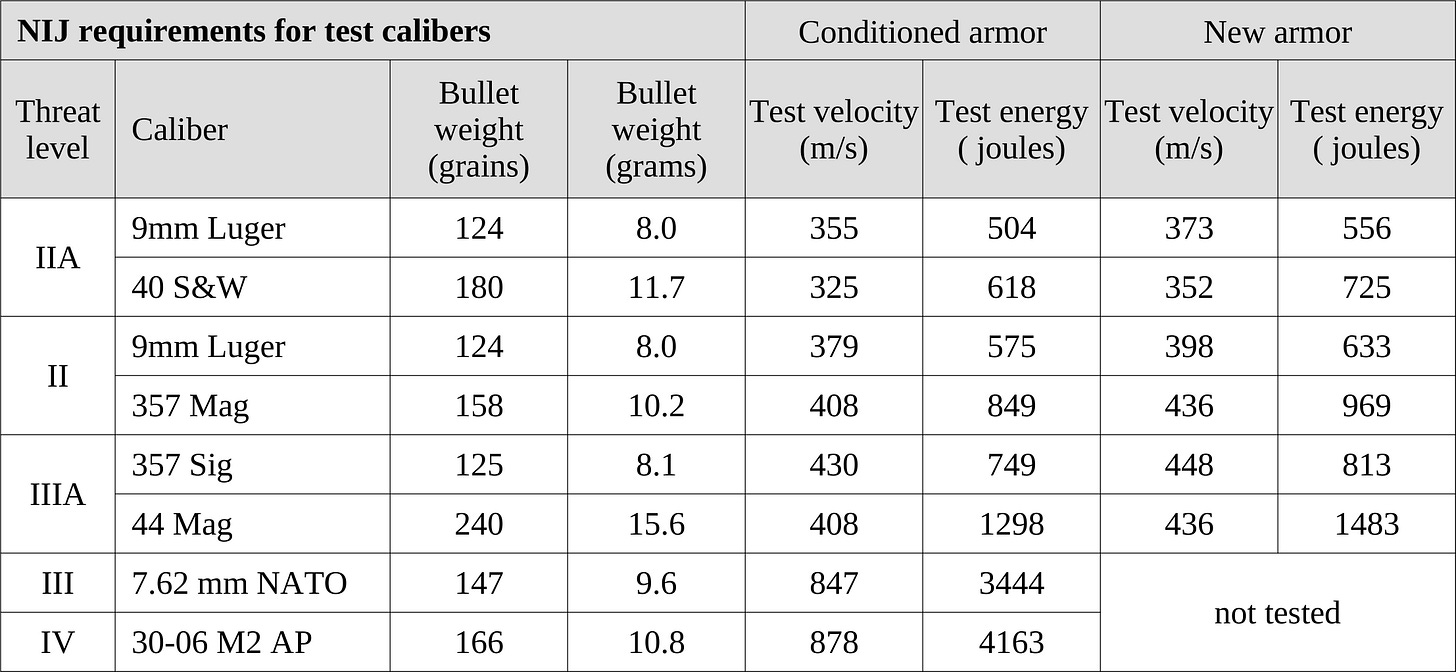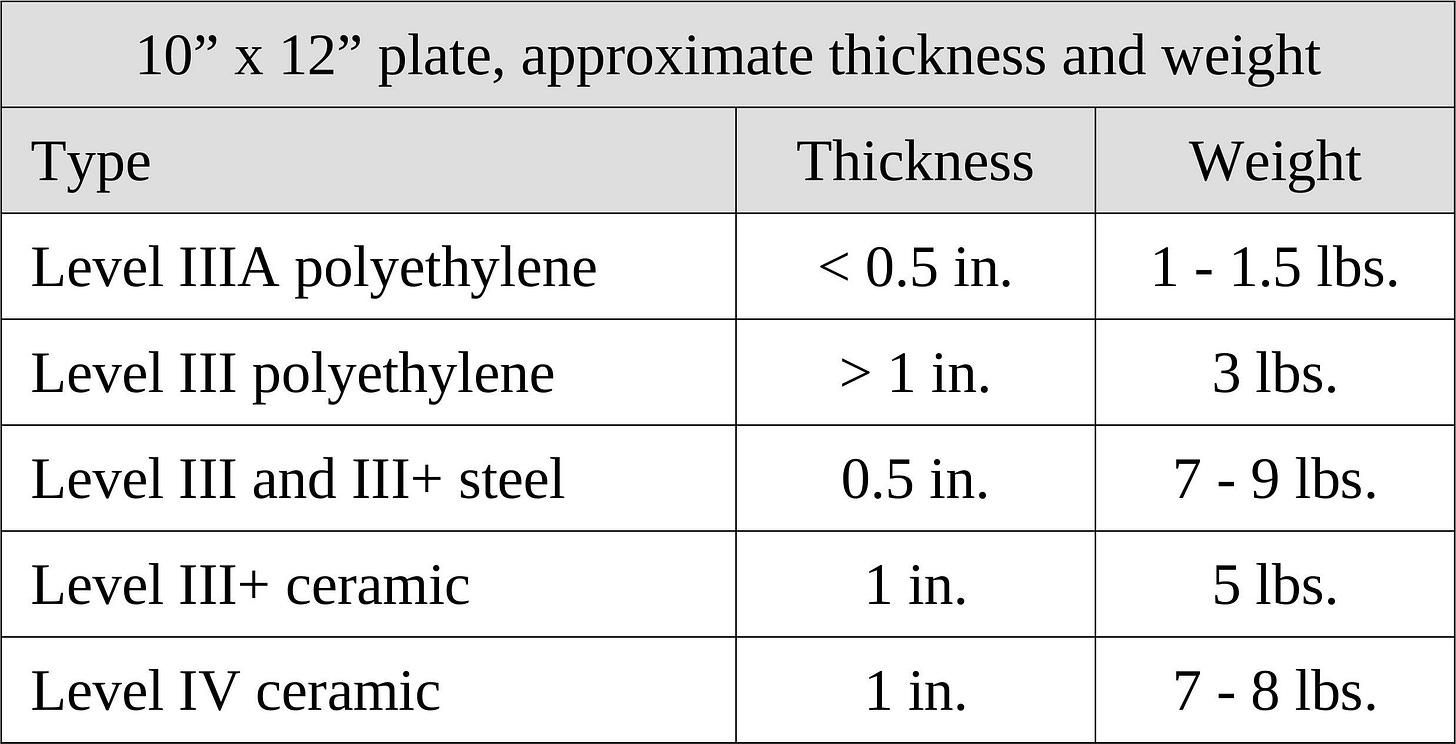"Assault Weapons" Part 2: Ballistic Protection
How "bullet proof" is a bullet proof vest? What does this have to do with rifles like the AR-15?
Welcome to Part 2 of a discussion about the firearms being characterized as “assault weapons.” In Part 1 we looked at the definitions of assault rifle and assault weapon, as well as some details about the AR-15.
This time we’re looking at ballistic protection, and its theoretical effectiveness against different types of cartridges - including the most common one used in AR-15 style rifles.
Wearable ballistic protection comes in many forms, but fortunately for us there’s a set of testing standards developed by the National Institute of Justice, which is part of the U.S. Department of Justice. The testing standards document, Ballistic Resistance of Body Armor NIJ Standard-0101.061, also provides us lots of useful info on types of bullets.
The Basics
Wearable ballistic armor comes mostly in two forms: wraparound vests such as those worn by law enforcement officers (LEOs) and plate carriers like the military uses.
Wraparound vests often provide more complete coverage but use flexible plates - which aren’t nearly as protective as hard armor plates. The more conforming fit also means many can be worn underneath clothing.
Plate carriers have large pockets to hold plates in the front and back (and sometimes on the sides) and the plates are removable so the armor level can be changed. Many carriers also have ways to attach things (like ammo pouches) to the surface so they can act as load bearing vests.
Modern soft core ballistic armor plates are usually made from polyethlyene, and hard core armor is either steel or ceramic - which of course aren’t flexible, and weigh much more than soft core plates.
Ballistic protection levels
Manufacturers of ballistic protection have their products tested and certified (by testing companies) to various NIJ protection levels. Each level is called a type, and each type is tested with specific handgun or rifle ammunition.
Personal body armor covered by this standard is classified into five types (IIA, II, IIIA, III, IV) by level of ballistic performance. In addition, a special test class is defined to allow armor to be validated against threats that may not be covered by the five standard classes.
There was a Type I, but it’s obsolete and no longer tested. Per the NIJ standard the other five types, or threat levels, are defined as:
Type IIA (9 mm; 40 S&W)
Type II (9 mm; 357 Magnum)
Type IIIA (.357 SIG; 44 Magnum)
Type III (Rifles)
Type IV (Armor Piercing Rifle)
The standard also allows for the definition of special test classes. This enables manufacturers to create ratings for resistance to calibers other than those already in the standard - such as the 5.56 NATO/223 Remington that’s the most common caliber used in the AR-15.
The NIJ standard requires environmental and mechanical conditioning of soft core armor for testing (but not hard core plates). These plates are tested both new and in the conditioned state. Level IIA, II, and IIIA armors are generally soft core.
Calibers used in testing
The standard provides a useful chart summarizing the exact calibers and bullet weights to be used in the tests for each level.
Bullet weights are listed by grams and by grains2 - grains is an old terminology but still in very common use, and when you buy ammunition this is the bullet weight listed on the box.
9 mm Luger: The NATO standard for military sidearms and still the most common law enforcement round, as well as the most common round sold. Almost everybody owns a 9 mm.
40 S&W: A little more powerful than 9 mm, the 40 Smith & Wesson was designed to have the energy of the old 45 ACP but still fit in the new generation of 9 mm pistols. It’s become popular with law enforcement.
357 Magnum: Developed from the old 38 Special, this round has about twice the energy of 9 mm Luger and is the most popular magnum revolver cartridge.
357 SIG: Intended to provide the performance of a 357 Magnum in a pistol cartridge, the 357 SIG has better penetration than 9 mm. It’s essentially a 40 S&W cartridge, necked down to a .355” bullet.
44 Magnum: Does this one need an introduction? Although no longer the most powerful revolver cartridge, it’s the highest energy handgun cartridge used in the tests.
7.62 mm NATO: the standard NATO full power rifle cartridge, it has much more energy than the standard AR-15 round. The civilian version is 308 Winchester.
30.06 M2 AP (30-06 armor piercing): The old 30-06, but with a steel core bullet. Although the new 7.62 NATO is almost as powerful, the 30-06 is still used as the test reference. Also, it’s often pronounced the old-fashioned way - “thirty ought-six” - because the 06 stands for 1906.
Types of bullets
In case you’re not familiar with bullet types, here are the definitions (paraphrased slightly) from the NIJ standard:
RN (Round Nose) - A bullet with a blunt or rounded nose. Includes bullets with a small flat surface at the tip.
FMJ (Full Metal Jacketed) - A lead core completely covered, except for the base, with copper alloy. TMJ (Total Metal Jacket) and TEMC (Totally Enclosed Metal Case) have copper on the base, and are considered comparable to FMJ for the purpose of testing.
JSP (Jacketed Soft Point) - A lead core covered, except for the nose, with copper alloy. Also known as a Semi Jacketed Soft Point (SJSP).
JHP (Jacketed Hollow Point) - A lead core with a hole or cavity in the nose, and covered in copper alloy except for the cavity.
SJHP (Semi Jacketed Hollow Point) - A lead core with a hole or cavity in the nose, and covered in copper alloy but leaving some portion of the lead core exposed.
Note that for testing, the pistol cartridges3 all use FMJ or TMJ so they have solid cores, and copper jackets at the point of impact. The two magnum revolver cartridges are soft point and hollow point, which will expand more readily than FMJ.
Level IV testing uses an armor piercing round, which in this case means it has a steel core.
The actual tests
The NIJ standard defines not just the bullet calibers and weights, but also the test velocities. The test velocities are slightly different from the muzzle velocities listed in the SAAMI standards.
This dense little chart summarizes all the tests:
That’s hard to read, so here’s a summary of weights and velocities along with calculated kinetic energy in joules:
Note a very interesting detail in this chart. The rifle rounds aren’t larger or heavier than all of the handgun rounds.
The handgun rounds (9 mm, 40 S&W, 357 Magnum, 357 SIG, 44 Magnum) are .35 inches or larger, and low velocity - 325 to 448 meters/second.
The rifle rounds are smaller diameter (.30 inches) but much higher velocity - 847 m/s and 878 m/s.
The most common round used in the AR-15 is even smaller and higher velocity - 5.56 mm NATO (223 Remington) is about .223 inches in diameter with a muzzle velocity of up to 1,000 m/s. But notice there’s no test using this round. This is where we get into manufacturer-defined tests.
Time to explain the M855
As we saw in Part 1, the new 5.56 NATO cartridge (designated the M193) was initially considered just barely powerful enough for combat. In the quest for increased lethality the U.S. military has made several updates to the standard cartridge.
The most well-known of these is the M855 light armor piercing round, often called “green tips” because the bullet tips are painted green to identify them from other cartridge types. Like other armor piercing rounds, this cartridge uses a bullet with a steel core to increase penetration through body armor and obstacles.
Whether the M855 or a standard soft point bullet is more deadly depends largely on what you’re wearing, which is why this round is given its own category in the testing of ballistic protection.
Special test classes
Recall the standard allows manufacturers to run tests at their own defined levels, so some manufacturers have created a level at which they test 5.56 NATO or 7.62 x 39 mm (the standard round for the AK-47).
One of those manufacturers is Spartan Armor Systems. Here’s a similar chart as above, but with their level III+ included. The lines highlighted in yellow show which tests were added - the NIJ standard doesn’t include 5.56 NATO or non-armor piercing 30-06.

The folks at Spartan have added the most common AR-15 soft core round (55 grains), the most common military round (M855), and the non-armor piercing 30-06 (nobody hunts deer with AP rounds).
Based on their website, their level III plates stop soft core 5.56 NATO. In addition, they have defined level III+ as protection against steel core 5.56 NATO and soft core 30-06.
Note that soft core 5.56 NATO has only slightly more kinetic energy than 44 Magnum but due to its much higher velocity will defeat level IIIA. And with a steel core it has similar penetration to a non-armor piercing 30-06 round with more than twice as much energy.
Once again, velocity matters. 5.56 NATO/223 Remington is at the lower end of kinetic energy for centerfire rifle cartridges so we would expect many rifle rounds to penetrate level IIIA. Add a steel core and the bullet is very difficult to stop.
Wearing ballistic protection
Now let’s look at some practical examples of ballistic protection. Here are some approximate thicknesses and weights for a single plate for a plate carrier. (10” x 12” plate, which is the most common size)
Two steel plates (front and back) can be 18 lbs. combined, and if side plates (which are smaller) are added the total weight for the carrier can be 25 - 30 lbs. Ceramic plates cuts this in half, but those are very expensive and come with an important caveat: most can only take a limited number of hits.
A concealable, level IIIA vest weighs only a few lbs, is flexible, and in many cases is even somewhat concealable. It’s a big difference.
Some important points
Typical, flexible law enforcement soft-core ballistic armor will stop almost any round that is practical to use in a handgun, but will not stop most rifle rounds.
To have similar protection against rifle rounds, either steel or ceramic core armor is required. This is much heavier and bulkier than soft core armor - easily five or ten times heavier, up to 30 lbs. just to cover the most vital areas of the body.
One commonly available, cheap round for the AR-15 is the steel-cored M855 (sold as military surplus), which has ballistic armor penetration on par with cartridges that are twice as powerful.
The extremely blunt summary
Citizens armed with handguns are very dangerous to each other, but pose much less of a threat to properly armed and equipped government agents (such as regular law enforcement officers, the FBI, armed IRS agents, etc.). Those agents are equipped with ballistic protection sufficient to stop nearly all handgun rounds. (As well as small rifles firing .22 LR, the cartridge that’s excepted in the proposed ban - which is why it’s given an exemption.)
Those same citizens are a much more serious threat if each has a semiautomatic weapon chambered for the 5.56 NATO cartridge, even more so if they purchase military surplus ammunition (the M855). The majority of weapons specifically named by “assault weapon” bans are these weapons.
The 5.56 NATO/223 Remington cartridge is cheap and effective. Among rifles chambered for this cartridge, the AR-15 types are inexpensive, easy to fire, and easy to maintain. Of existing firearms, it’s the best one to own if your plans this afternoon include overthrowing a tyrannical dictatorship.
In the meantime, keep a hold of those M855s. In the post-apocalypse they’ll probably be the most valuable form of currency left.
NIJ ballistic resistance standard: https://www.ojp.gov/pdffiles1/nij/223054.pdf
For conversion, one gram is 15.43 grains.
Most manufacturers call semiautomatic handguns “pistols” to distinguish them from revolvers. Revolver cartridges have protruding rims at the base so they don’t fall through the cylinder, while pistol cartridges have recessed rims so they can stack in magazines (these are, confusingly, called “rimless”cartridges). Some revolvers are designed to use special “moon clips” so they can fire rimless cartridges. Moon clips are more commonly used with rimmed cartridges, for fast reloading.







What a splendid read, loved this 2 article series ! wish i could easily own a gun, but alas, EU govt says NOPE